Design to Deployment: Flight Schedule-Based Analysis of Hybrid Electric Aircraft Variants in U.S. Regional Carrier Operations
Abstract
1. Introduction
1.1. Utilizing Market Data
1.2. Electrified Aircraft Operations
2. Research Scope: HEA Integration into Regional Airline Operations
3. Market Analysis and Representative Aircraft Identification
- Mission Range: The distance flown by the aircraft from its origin to its destination, collected from BTS T-100 data;
- Computerized Reservation System (CRS) Departure and Arrival Times: The times that the aircraft was scheduled to depart and arrive at the gate, based on the airline’s reservation system, collected from BTS on-time performance data;
- Air Time: The wheels-up (lifting off during takeoff) to wheels-down (touchdown upon landing) time, measured in minutes and collected from BTS on-time performance data;
- Departures Performed: The number of times that an aircraft departs from a given origin airport over the course of one month, collected from BTS T-100 data;
- Passengers: Average number of non-stop segment passengers transported, collected from BTS T-100 data;
- Payload: Payload transported on a given flight, collected from BTS T-100 data.
4. Hybrid Electric Aircraft Sizing
- A “baseline” aircraft that flies 3980 km, the range that the ERJ175LR was designed for [23];
- A “reduced range” aircraft that flies 1850 km, a mission range that covers 76% of regional airline services explored in the market analysis.
- Rapid aircraft sizing to facilitate design space exploration;
- A database of over 450 aircraft used to drive regressions for the prediction of unknown aircraft performance and design parameters;
- Ability to model any propulsion architecture, opening the possibility to compare disparate aircraft concepts at a conceptual design level;
- Detailed turbofan models for engine sizing analysis.
4.1. Baseline ERJ175LR Modeling
4.2. HEA Variant Design
4.3. Designs Selected for Operational Analysis
5. Aircraft Operations Analysis
5.1. Sequence Compilation
5.2. Sequence Simulation
5.3. Flight Operations Simulations
- Once the battery reaches 20% SOC, it is no longer used. The aircraft only flies using its turbofan engines. Not only does this imply that the battery could be “turned off” in the middle of a takeoff or climb segment, but this renders the flight “infeasible”, meaning that the power management strategy was not fully adhered to.
- The battery is only used during the respective mission segments (either takeoff only or takeoff and climb). After flying the respective mission segments with the battery, any additional battery energy is not expended.
- The battery’s final SOC and fuel burn are recorded after the main mission is completed. The reserve mission is included to calculate the necessary fuel requirements.
6. Conclusions
Author Contributions
Funding
Data Availability Statement
Acknowledgments
Conflicts of Interest
Abbreviations
| BTS | Bureau of Transportation Statistics |
| CRS | Computerized Reservation System |
| FAST | Future Aircraft Sizing Tool |
| HEA | Hybrid Electric Aircraft |
| MTOW | Maximum Takeoff Weight |
| OD pair | Origin–Destination pair |
| OEW | Operational Empty Weight |
| PHE | Parallel Hybrid Electric |
| SOC | State of Charge (%) |
| TLAR | Top-Level Aircraft Requirement |
| TOGW | Takeoff Gross Weight |
| TSFC | Thrust-Specific Fuel Consumption |
Appendix A. Baseline Aircraft Design Mission Profile
| Mission | Segment | Initial Altitude [m] | Final Altitude [m] | Initial Airspeed (m/s or Mach) | Final Airspeed (m/s or Mach) |
|---|---|---|---|---|---|
| Main Mission— Design Range | Takeoff | 0 | 0 | 0 TAS | 69.45 TAS |
| Initial Climb | 0 | 914 | 69.45 TAS | 102.89 EAS | |
| Main Climb | 914 | 10,668 | 102.89 EAS | 102.89 EAS | |
| Accelerate | 10,668 | 10,668 | 102.89 EAS | Mach 0.78 | |
| Cruise | 10,668 | 10,668 | Mach 0.78 | Mach 0.78 | |
| Decelerate | 10,668 | 10,668 | Mach 0.78 | 108.03 EAS | |
| Main Descent | 10,668 | 914 | 108.03 EAS | 108.03 EAS | |
| Final Descent | 914 | 457 | 108.03 EAS | 83.34 TAS | |
| Reserve— 100 nmi Diversion | Initial Climb | 457 | 914 | 83.34 TAS | 102.89 EAS |
| Main Climb | 914 | 2743 | 102.89 EAS | 102.89 EAS | |
| Final Climb | 2743 | 3048 | 102.89 EAS | 128.61 TAS | |
| Divert | 3048 | 3048 | 128.61 TAS | 128.61 TAS | |
| Reserve— 45 min Loiter | Loiter | 3048 | 3048 | 128.61 TAS | 128.61 TAS |
| Initial Descent | 3048 | 2743 | 128.61 TAS | 102.89 EAS | |
| Main Descent | 2743 | 914 | 102.89 EAS | 102.89 EAS | |
| Final Descent | 914 | 0 | 102.89 EAS | 83.34 TAS | |
| Landing | 0 | 0 | 83.34 TAS | 0 TAS |
Appendix B. Calibration Factors for Baseline ERJ175LR Model
| Calibration Factor | Value |
|---|---|
| Airframe Weight | 1.018 |
| Fuel Flow | 1.029 |
| Cruise | 1.002 |
| Climb/Descent | 1.000 |
Appendix C. Sized HEA Variants

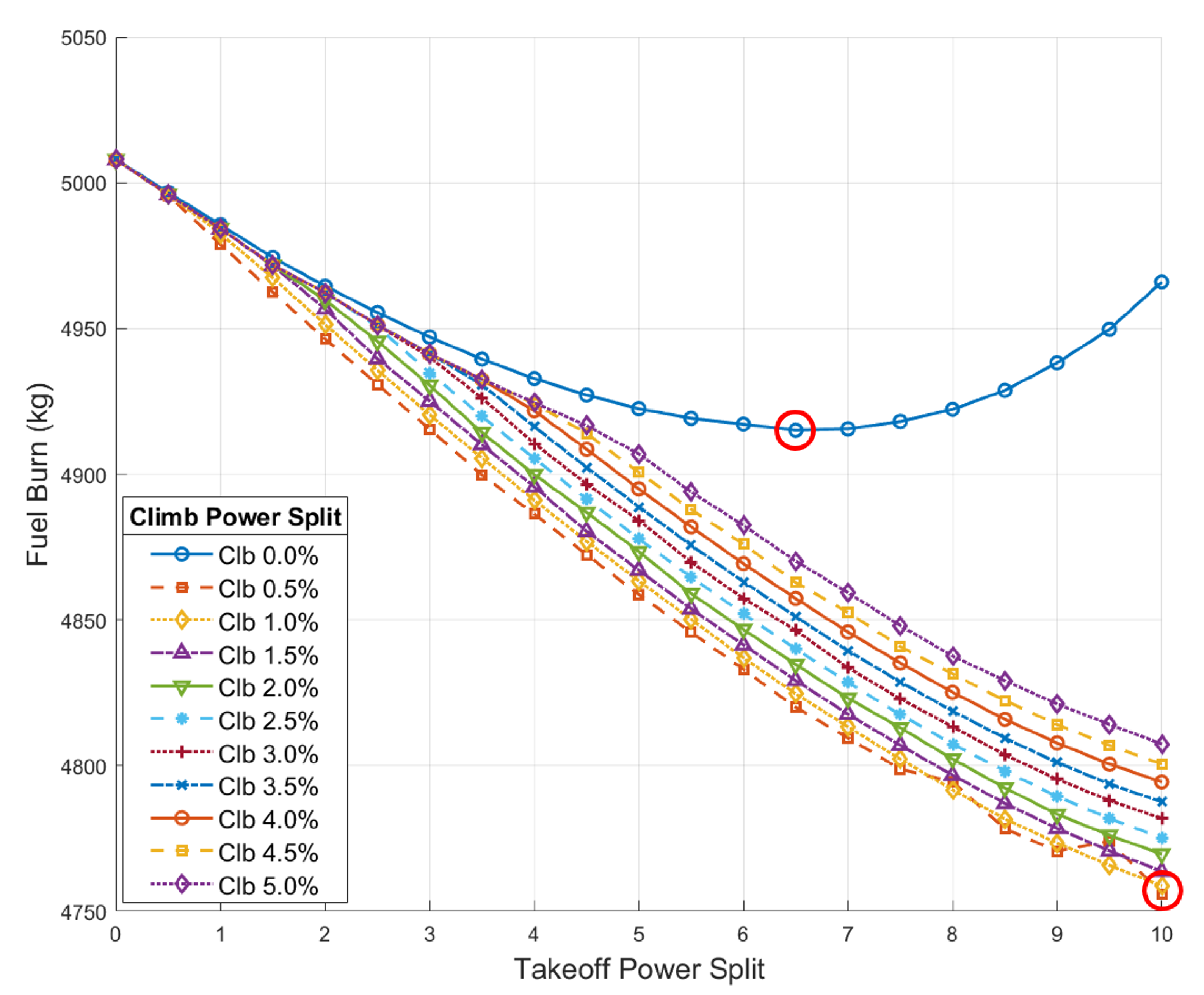
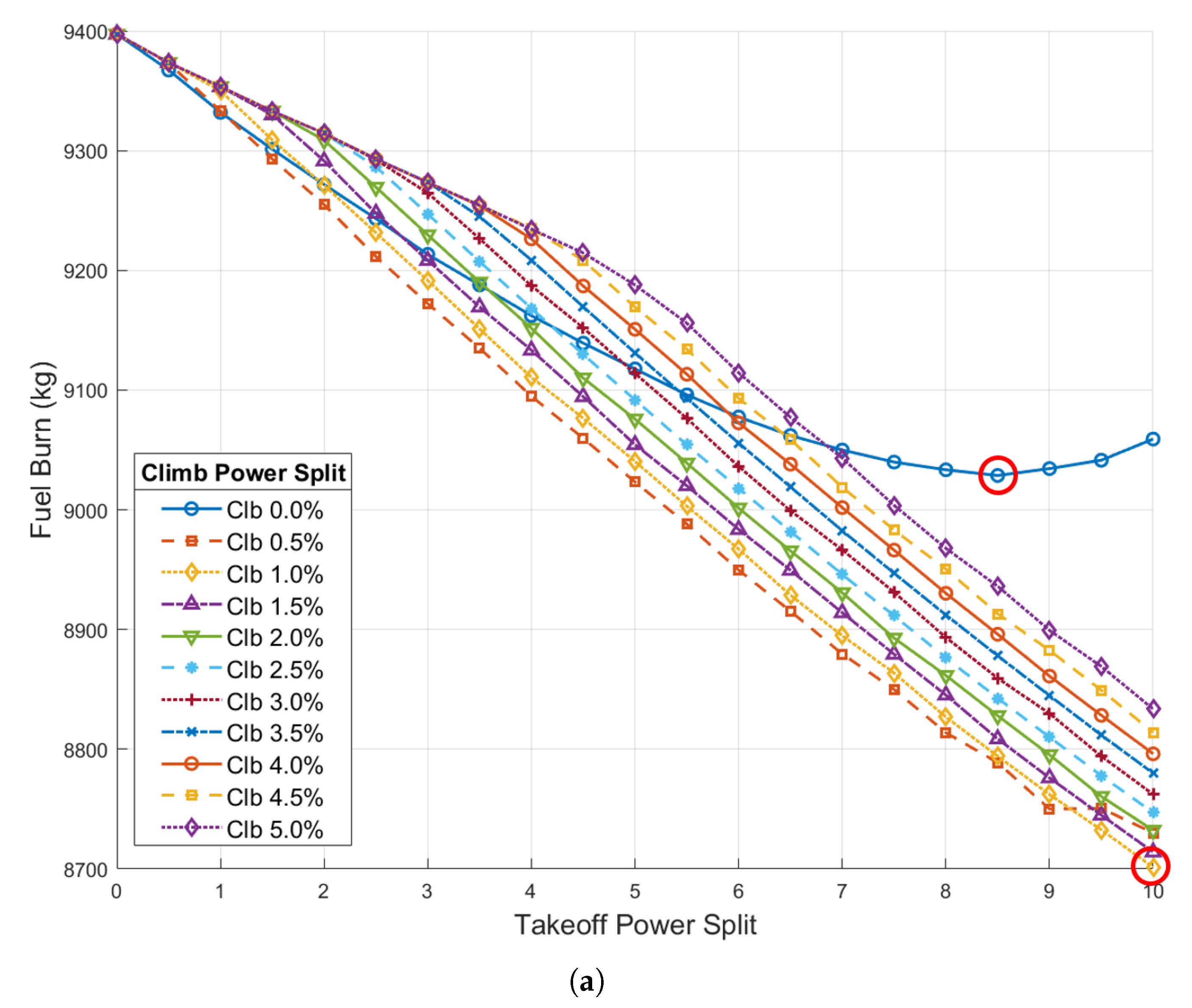

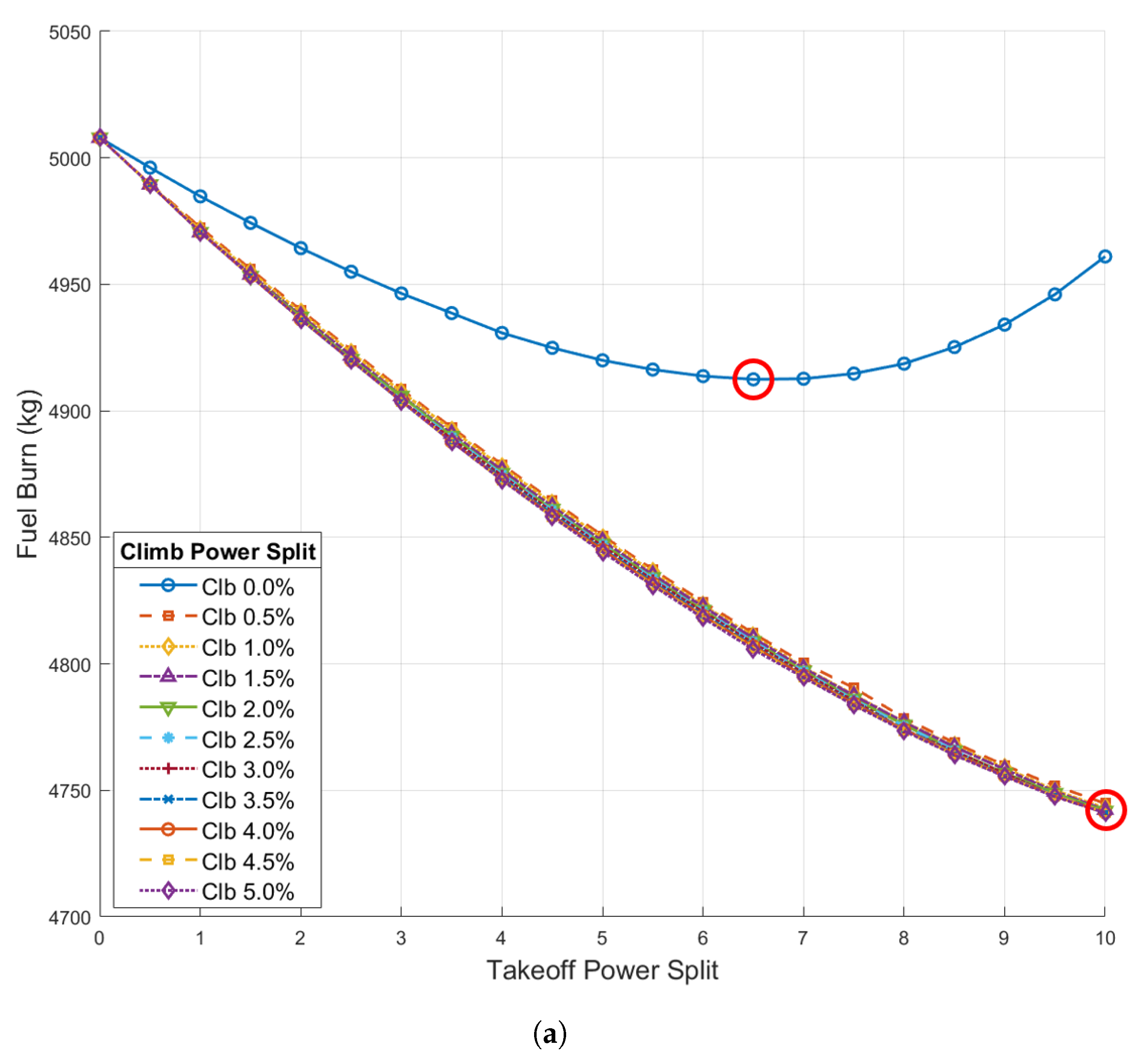
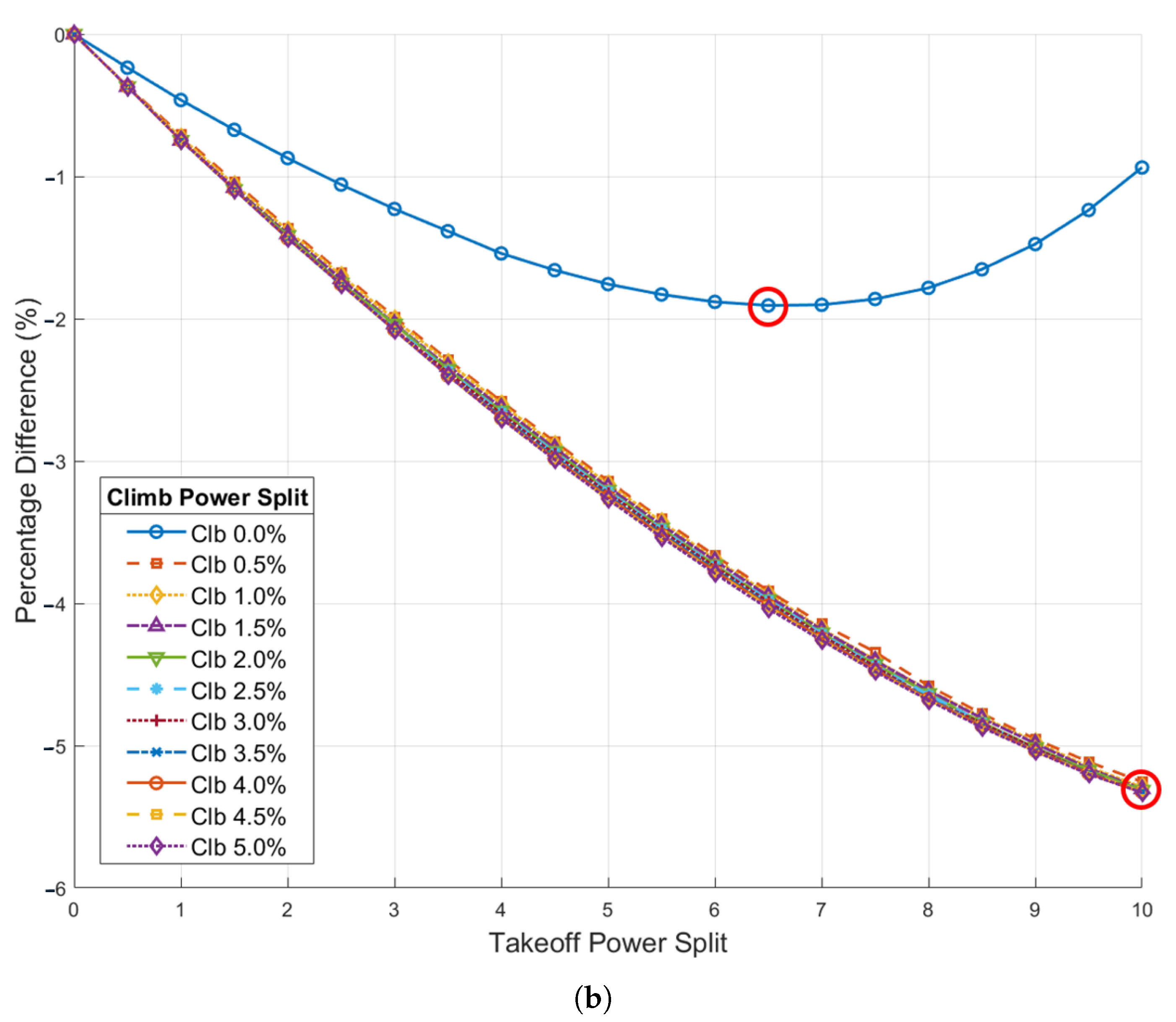
| HEA 6 | HEA 7 | |
|---|---|---|
| Takeoff Power Split [%] | 8.5 | 10 |
| Climb Power Split [%] | 0.0 | 1.0 |
| MTOW [kg] | 36,961 | 36,174 |
| OEW [kg] | 20,211 | 19,654 |
| Block Fuel [kg] | 9028 | 8701 |
| Battery Weight [kg] | 28 | 124 |
| Total Engine Weight [kg] | 2552 | 2453 |
| Total Thrust [kN] | 118.1 | 115.6 |
| SLS Engine Thrust [kN] | 54.0 | 52.0 |
| Avg. Climb TSFC | 14.40 | 14.62 |
| Avg. Cruise TSFC | 19.31 | 19.38 |
| Wing Area | 69.31 | 67.82 |
| Electric Motor Power [kW] | 697 | 803 |
| Electric Motor Weight [kg] | 69.7 | 80.3 |
| HEA 8 | HEA 9 | |
|---|---|---|
| Takeoff Power Split [%] | 6.5 | 10 |
| Climb Power Split [%] | 0.0 | 1.0 |
| MTOW [kg] | 26,229 | 25,902 |
| OEW [kg] | 13,606 | 13,581 |
| Block Fuel [kg] | 4912 | 4743 |
| Battery Weight [kg] | 16 | 88 |
| Engine Weight [kg] | 1807 | 1708 |
| Total Thrust [kN] | 83.8 | 82.7 |
| SLS Engine Thrust [kN] | 39.2 | 37.2 |
| Avg. Climb TSFC | 18.90 | 18.58 |
| Avg. Cruise TSFC | 23.75 | 23.34 |
| Wing Area | 49.15 | 48.50 |
| Electric Motor Power [kW] | 378 | 380 |
| Electric Motor Weight [kg] | 37.8 | 38.0 |
References
- Bowman, C.L.; Felder, J.L.; Marien, T.V. Turbo-and hybrid-electrified aircraft propulsion concepts for commercial transport. In Proceedings of the 2018 AIAA/IEEE Electric Aircraft Technologies Symposium (EATS), Cincinnati, OH, USA, 12–14 July 2018; pp. 1–8. [Google Scholar]
- Jansen, R.; Brown, G.V.; Felder, J.L.; Duffy, K.P. Turboelectric aircraft drive key performance parameters and functional requirements. In Proceedings of the 51st AIAA/SAE/ASEE Joint Propulsion Conference, Orlando, FL, USA, 27–29 July 2015; p. 3890. [Google Scholar] [CrossRef]
- Cinar, G.; Cai, Y.; Bendarkar, M.V.; Burrell, A.I.; Denney, R.K.; Mavris, D.N. System analysis and design space exploration of regional aircraft with electrified powertrains. J. Aircr. 2023, 60, 382–409. [Google Scholar] [CrossRef]
- Delta Airlines. Delta, JetZero Partner to Design the Future of Air Travel by Advancing First-of-Its-Kind, 50 and International Routes. 2025. Available online: https://news.delta.com/delta-jetzero-partner-design-future-air-travel (accessed on 27 April 2025).
- Reuters. United Airlines Invests in Aircraft Startup JetZero. 2025. Available online: https://www.reuters.com/business/aerospace-defense/united-airlines-invests-aircraft-startup-jetzero-2025-04-24/ (accessed on 27 April 2025).
- Lampert, A. United Airlines to Buy 100, 19-Seat Electric PLANES from Heart Aerospace. 2021. Available online: https://www.reuters.com/business/sustainable-business/united-airlines-buy-100-19-seat-electric-planes-heart-aerospace-2021-07-13/ (accessed on 27 April 2025).
- Lents, C.E.; Hardin, L.W.; Rheaume, J.; Kohlman, L. Parallel hybrid gas-electric geared turbofan engine conceptual design and benefits analysis. In Proceedings of the 52nd AIAA/SAE/ASEE Joint Propulsion Conference, Salt Lake Cit, UT, USA, 25–27 July 2016; p. 4610. [Google Scholar] [CrossRef]
- Hepperle, M. Electric Flight—Potential and Limitations; Technical Report; NATO Science and Technology Organization: Brussels, Belgium, 2012. [Google Scholar]
- Wroblewski, G.E.; Ansell, P.J. Mission analysis and emissions for conventional and hybrid-electric commercial transport aircraft. J. Aircr. 2019, 56, 1200–1213. [Google Scholar] [CrossRef]
- Geiß, I. Sizing of the energy storage system of hybrid-electric aircraft in general aviation. CEAS Aeronaut. J. 2017, 8, 53–65. [Google Scholar] [CrossRef]
- McDonald, R.A. Establishing mission requirements based on consideration of aircraft operations. J. Aircr. 2013, 50, 741–751. [Google Scholar] [CrossRef]
- Jansen, P.W.; Perez, R.E. Coupled Optimization of Aircraft Families and Fleet Allocation for Multiple Markets. J. Aircr. 2016, 53, 1485–1504. [Google Scholar] [CrossRef]
- Windhorst, R.D.; Lauderdale, T.A.; Cone, A.; Fong, R.K.; Palopo, K.; Pham, D.; Phillips, J. Analysis of Hybrid Electric Aircraft Operations in the National Airspace System. In Proceedings of the AIAA Aviation Forum and Ascend 2024, Las Vegas, NV, USA, 29 July–2 August 2024; p. 3958. [Google Scholar] [CrossRef]
- Davendralingam, N.; Crossley, W. Robust approach for concurrent aircraft design and airline network design. J. Aircr. 2014, 51, 1773–1783. [Google Scholar] [CrossRef]
- Geiß, I.; Notter, S.; Strohmayer, A.; Fichter, W. Optimized operation strategies for serial hybrid-electric aircraft. In Proceedings of the 2018 Aviation Technology, Integration, and Operations Conference, Atlanta, GA, USA, 25–29 June 2018; p. 4230. [Google Scholar] [CrossRef]
- Bonnin, V.O.; Hoogreef, M.F. Exploration of Off-Design Performance for Hybrid Electric Regional Aircraft. J. Aircr. 2025, 1–20. [Google Scholar] [CrossRef]
- Mitici, M.; Ramos Pereira, M.; Oliviero, F. Electric flight scheduling with battery-charging and battery-swapping opportunities. EURO J. Transp. Logist. 2022, 11, 100074. [Google Scholar] [CrossRef]
- Hamilton, T.; German, B.J. Optimal airspeeds for scheduled electric aircraft operations. J. Aircr. 2019, 56, 545–555. [Google Scholar] [CrossRef]
- Fredricks, M.A.; Justin, C.Y.; Mavris, D.N. Network Level Performance of In-Flight Recharge for Hybrid-Electric Regional Aircraft. In Proceedings of the AIAA AVIATION 2023 Forum, San Diego, CA, USA, 12–16 June 2023; p. 3324. [Google Scholar] [CrossRef]
- Bureau of Transportation Statistics. Air Carriers: T-100 Domestic Segment (U.S. Carriers). 2019. Available online: https://transtats.bts.gov/DL_SelectFields.aspx?gnoyr_VQ=FIM&QO_fu146_anzr=Nv4%20Pn44vr45 (accessed on 20 December 2023).
- Bureau of Transportation Statistics. On-Time: Reporting Carrier On-Time Performance (1987–Present). 2019. Available online: https://www.transtats.bts.gov/DL_SelectFields.aspx?gnoyr_VQ=FGJ&QO_fu146_anzr=b0-gvzr (accessed on 17 February 2024).
- Federal Aviation Administration. Aircraft Registration. 2025. Available online: https://www.faa.gov/licenses_certificates/aircraft_certification/aircraft_registry/releasable_aircraft_download (accessed on 12 April 2025).
- Embraer. E175. 2025. Available online: https://www.embraercommercialaviation.com/commercial-jets/e175/ (accessed on 13 March 2025).
- Mokotoff, P.; Arnson, M.; Wang, Y.C.; Cinar, G. FAST: A Future Aircraft Sizing Tool for Conventional and Electrified Aircraft Design. In Proceedings of the AIAA SciTech 2025 Forum, Orlando, FL, USA, 6–10 January 2025; p. 2374. [Google Scholar] [CrossRef]
- Gray, J.S.; Hwang, J.T.; Martins, J.R.R.A.; Moore, K.T.; Naylor, B.A. OpenMDAO: An open-source framework for multidisciplinary design, analysis, and optimization. Struct. Multidiscip. Optim. 2019, 59, 1075–1104. [Google Scholar] [CrossRef]
- Embraer. Embraer 175: Airport Planning Manual. 2015. Available online: https://www.embraercommercialaviation.com/wp-content/uploads/2017/02/APM_E175.pdf (accessed on 13 March 2025).
- European Union Aviation Safety Agency. Type-Certificate Data Sheet for Noise. 2022. Available online: https://www.easa.europa.eu/en/document-library/type-certificates/noise/easaima001-erj-170 (accessed on 13 March 2025).
- Federal Aviation Administration. FAA Type Certificate Data Sheet No. A56NM. 2022. Available online: https://drs.faa.gov/browse/excelExternalWindow/22037ED8FF40F56A862587D4004E3443.0001 (accessed on 13 March 2025).
- European Union Aviation Safety Agency. Type Certificate Data Sheet No.IM.E.053; Technical Report 4; EASA: Cologne, Germany, 2023.
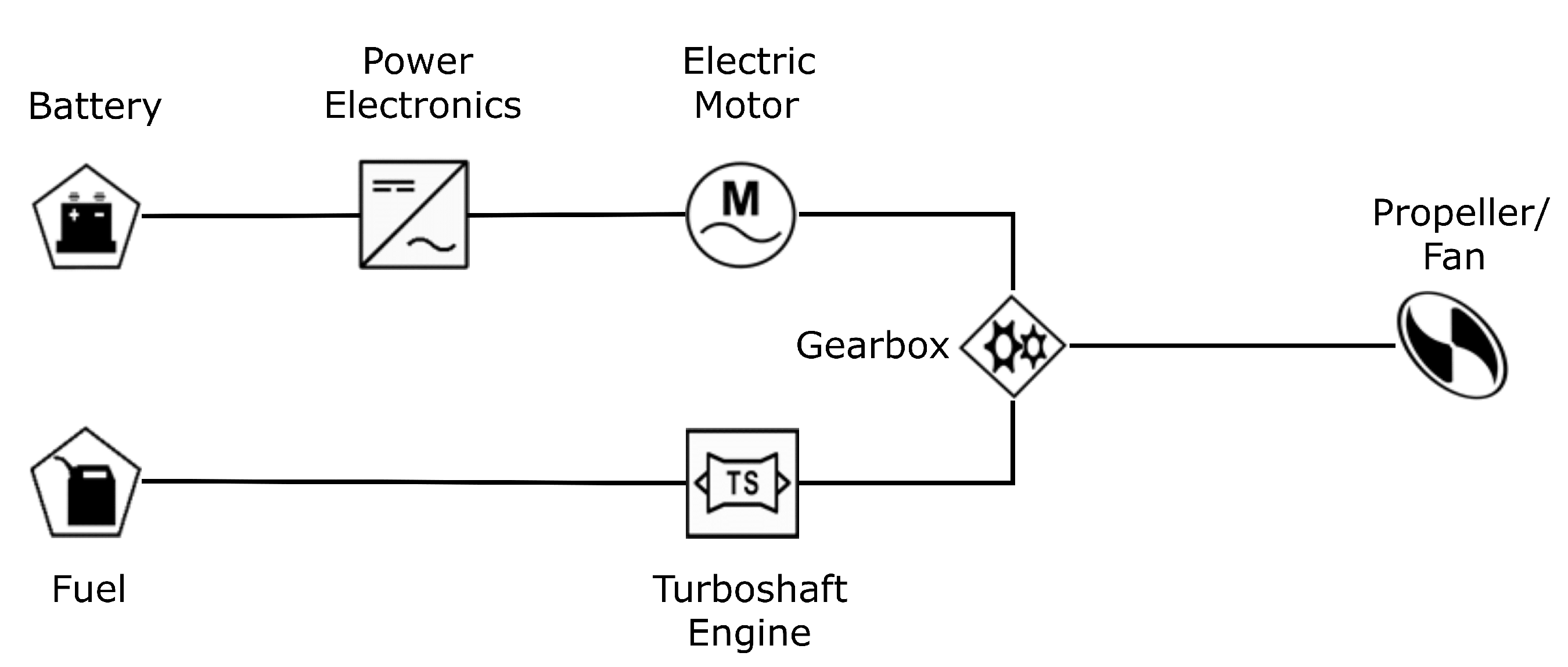
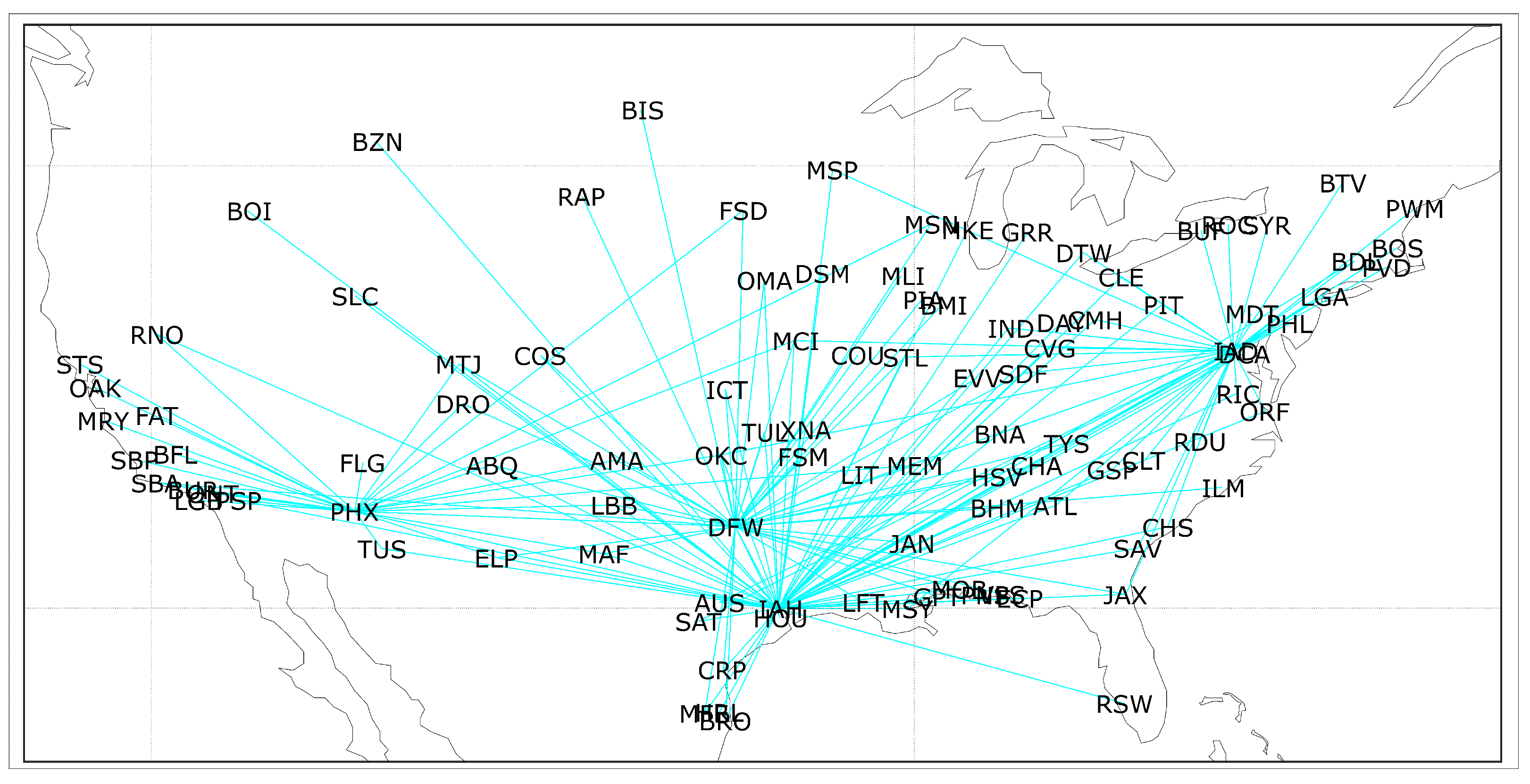
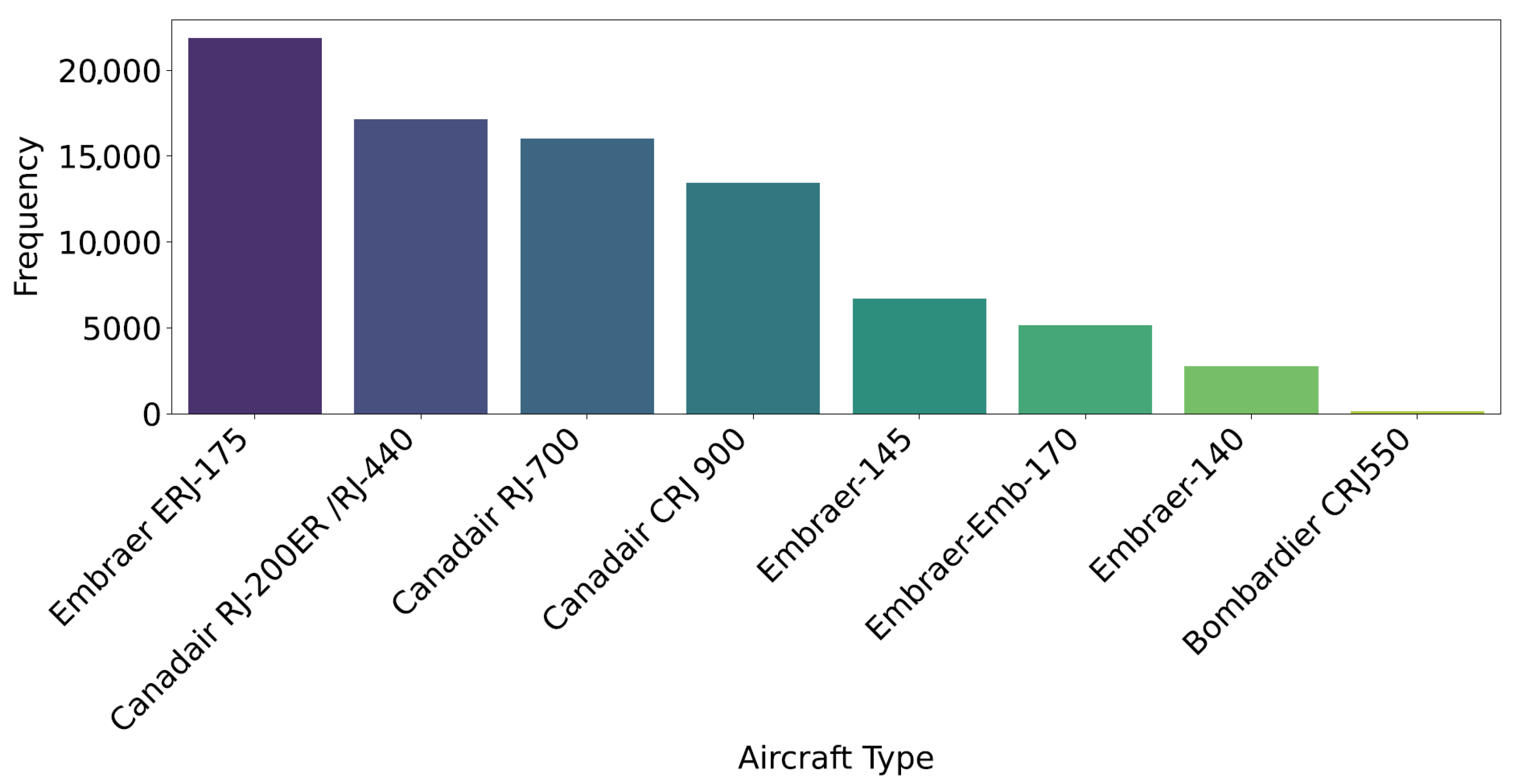
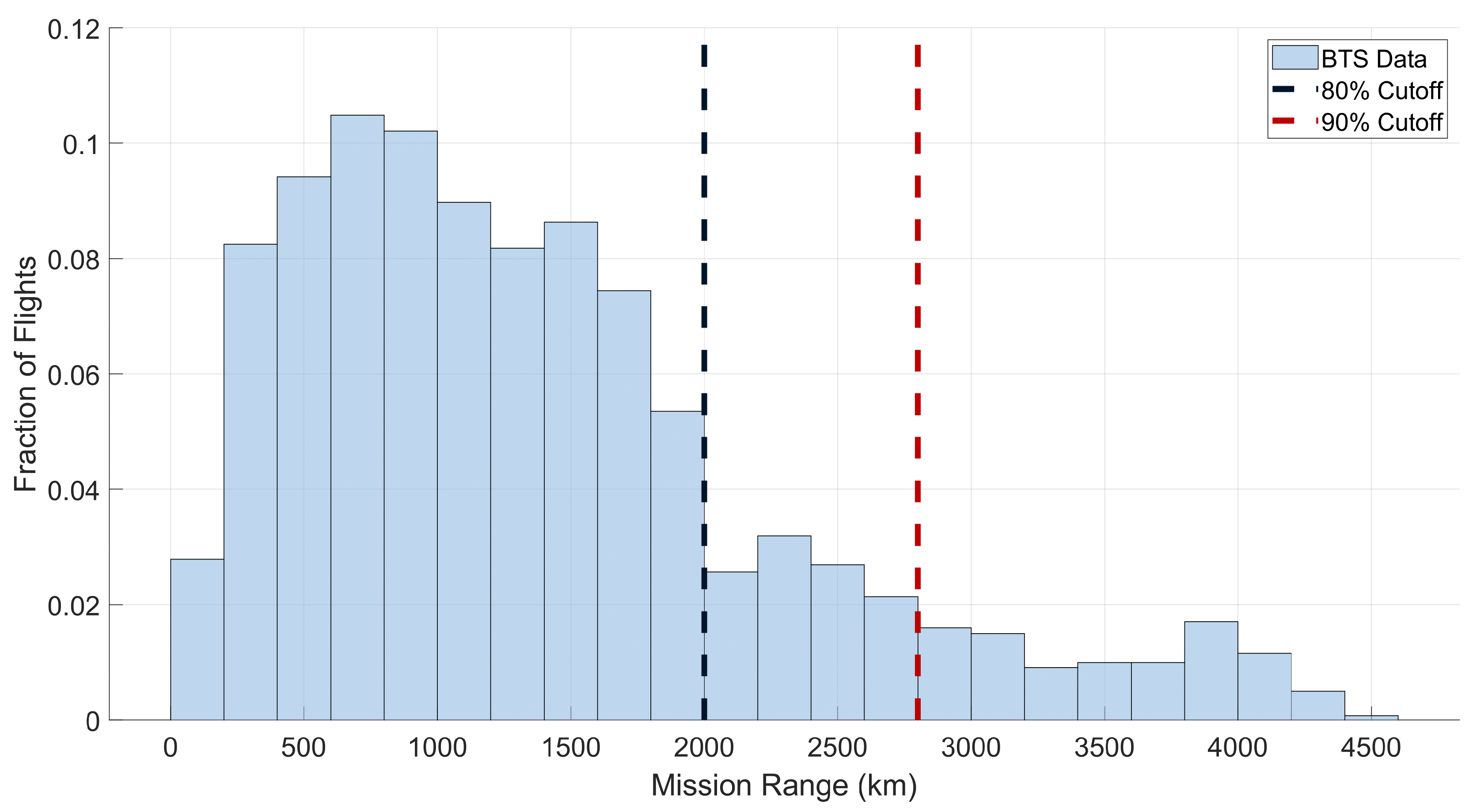

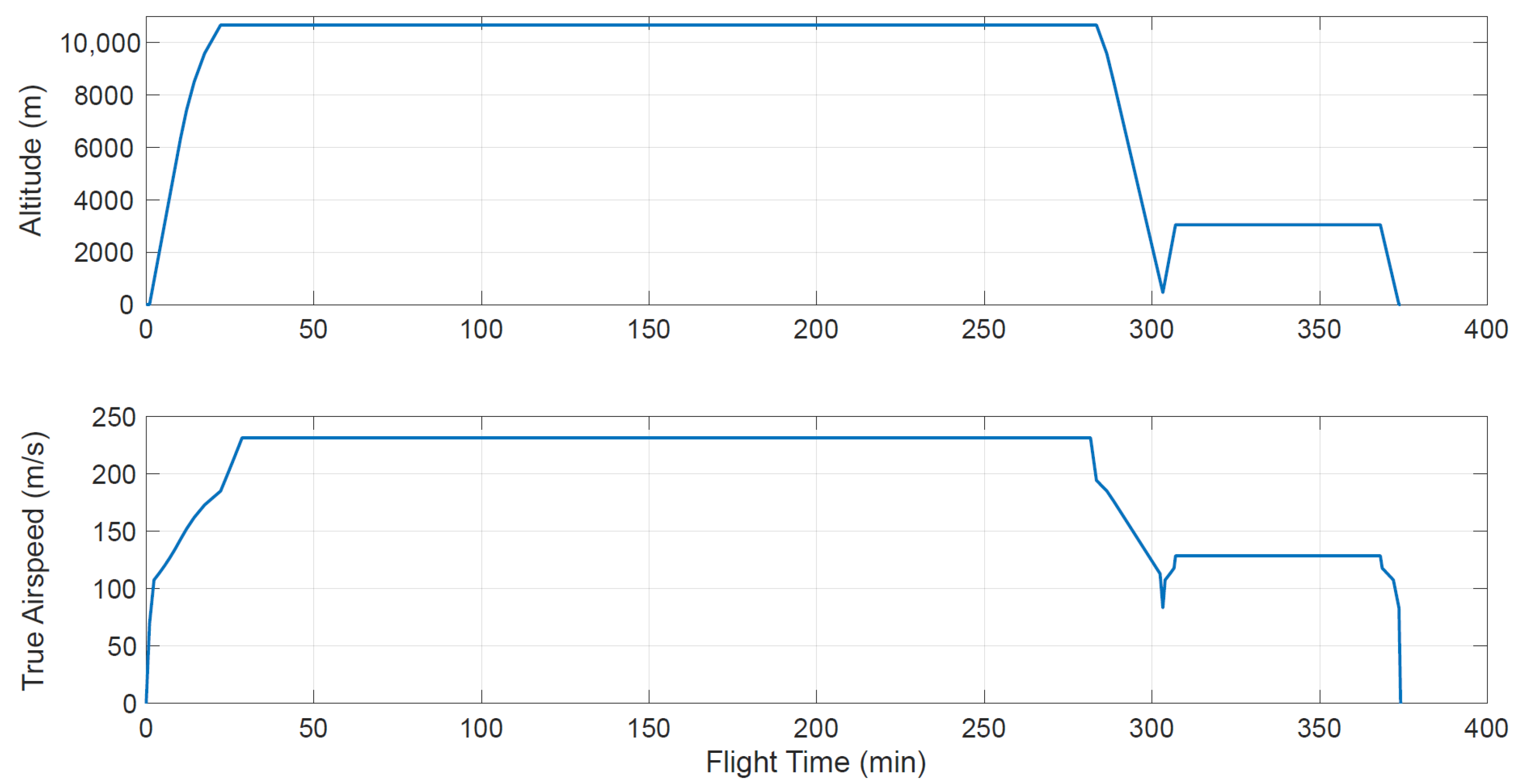
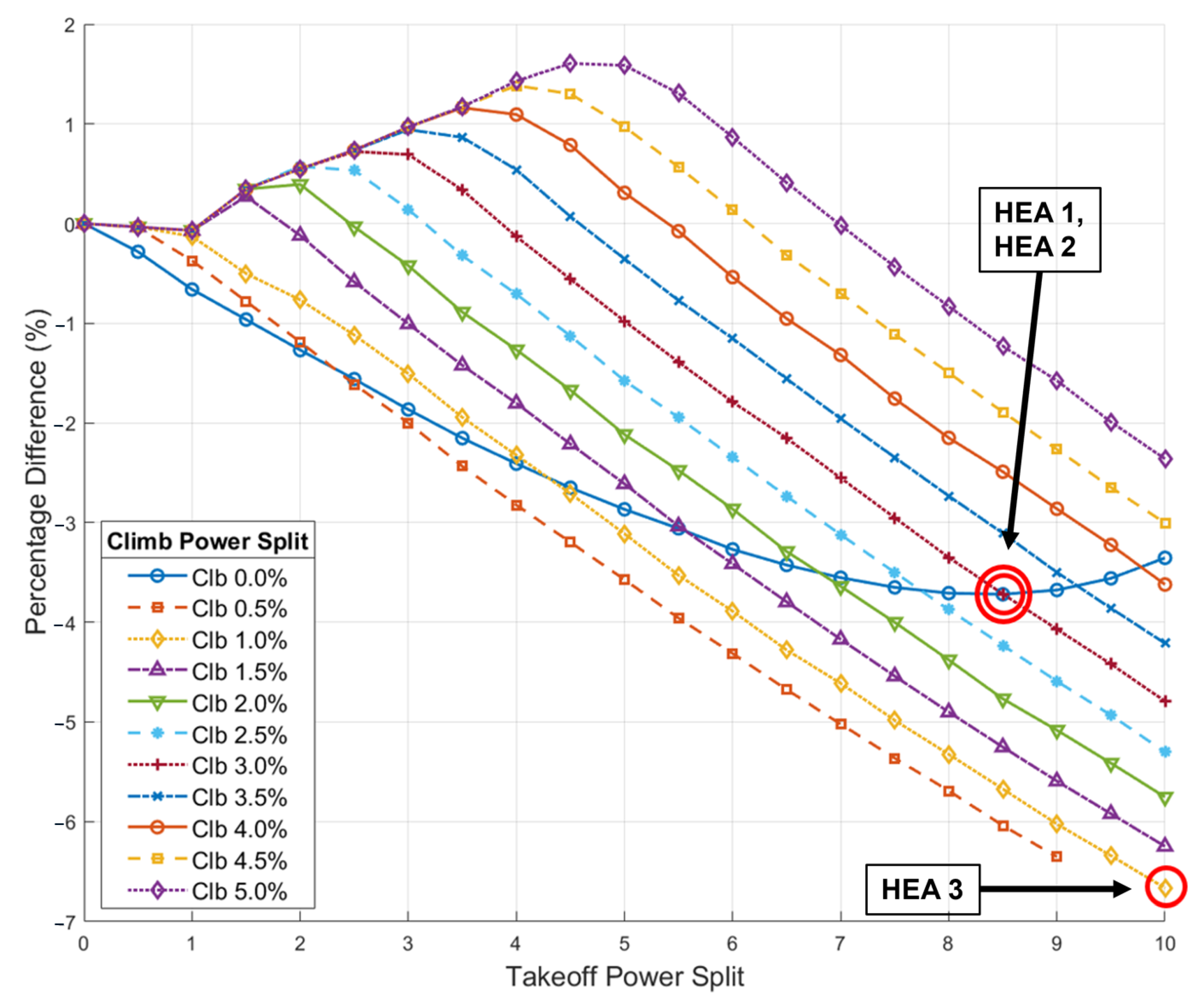
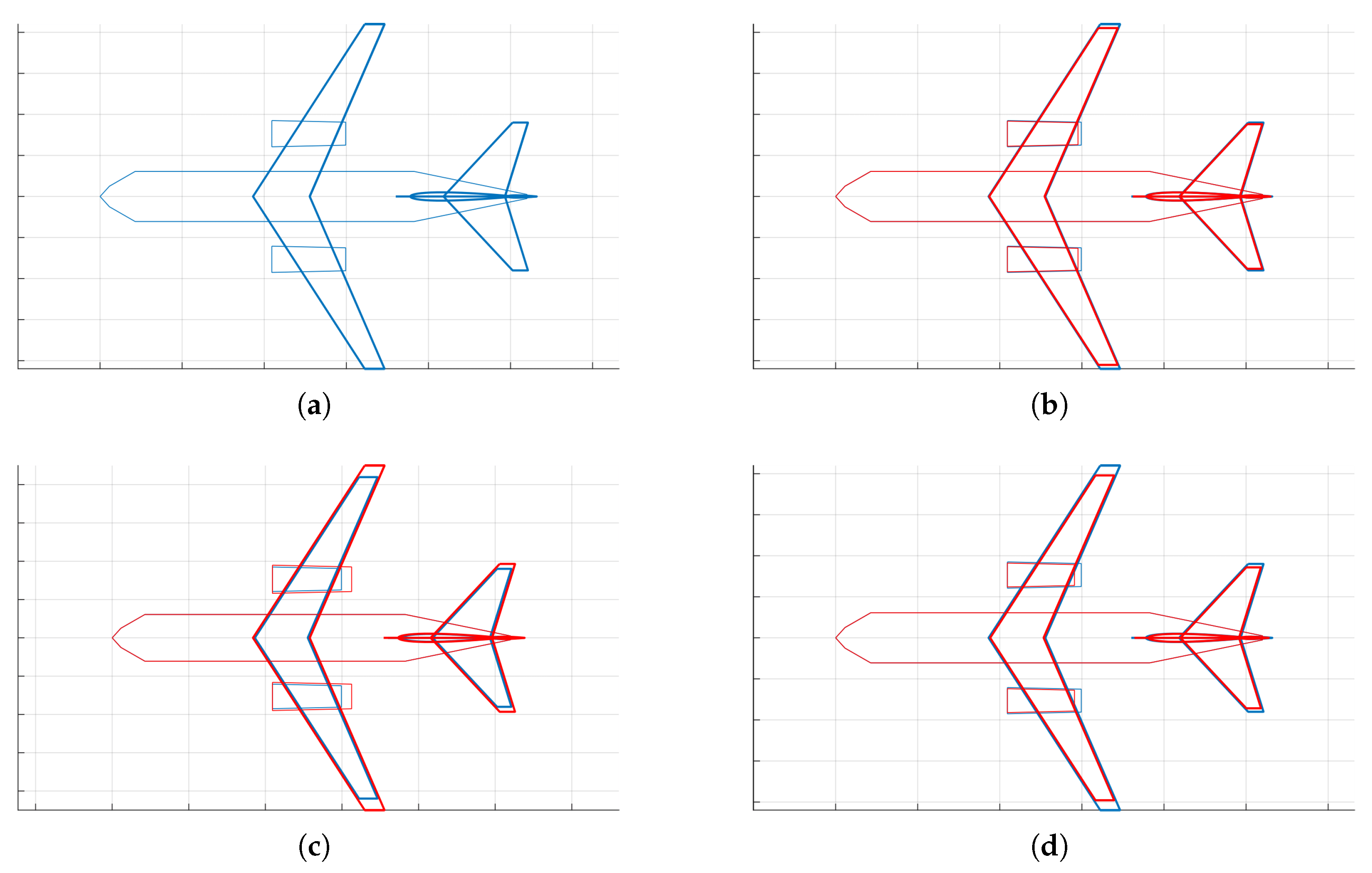
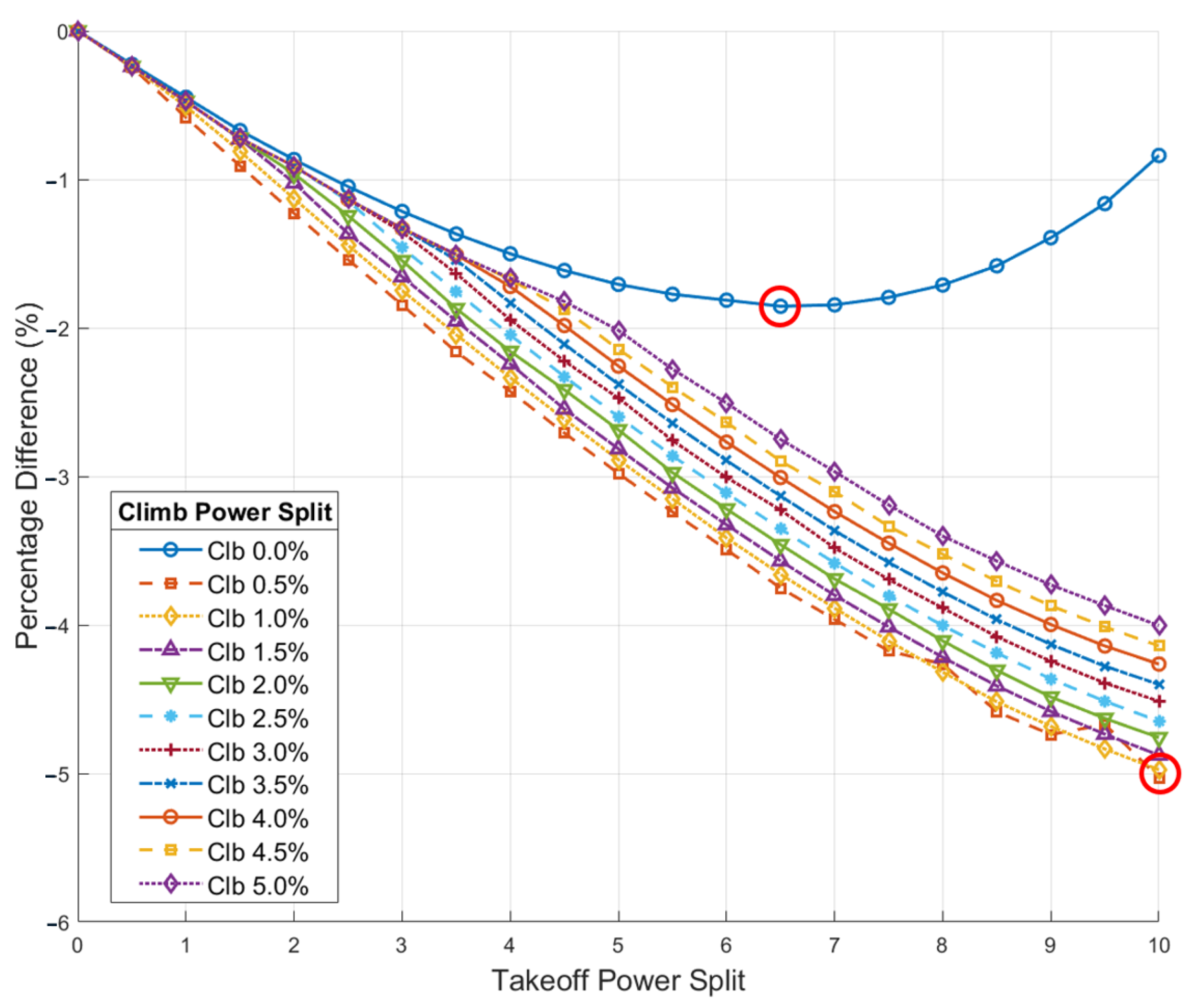

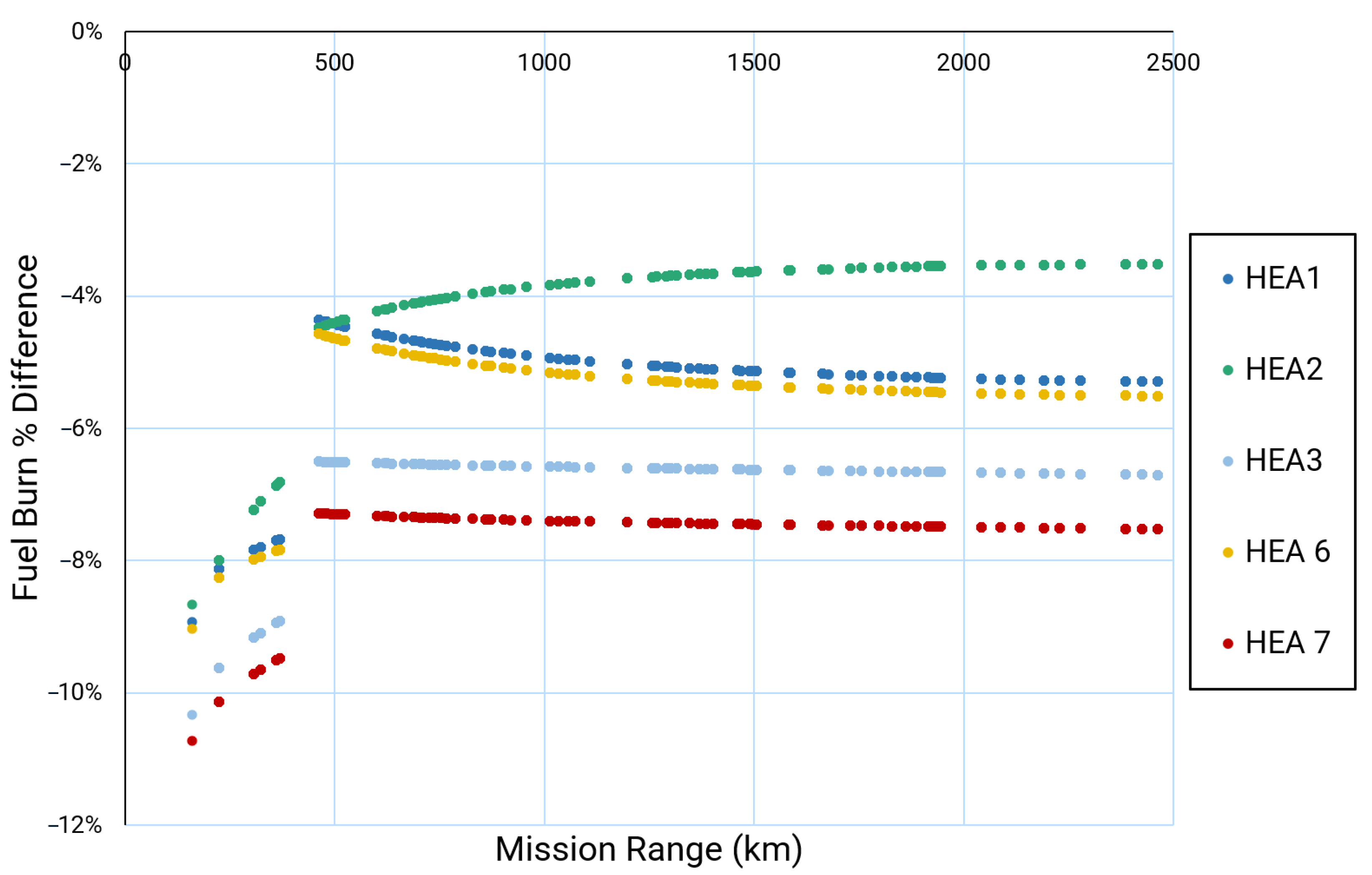
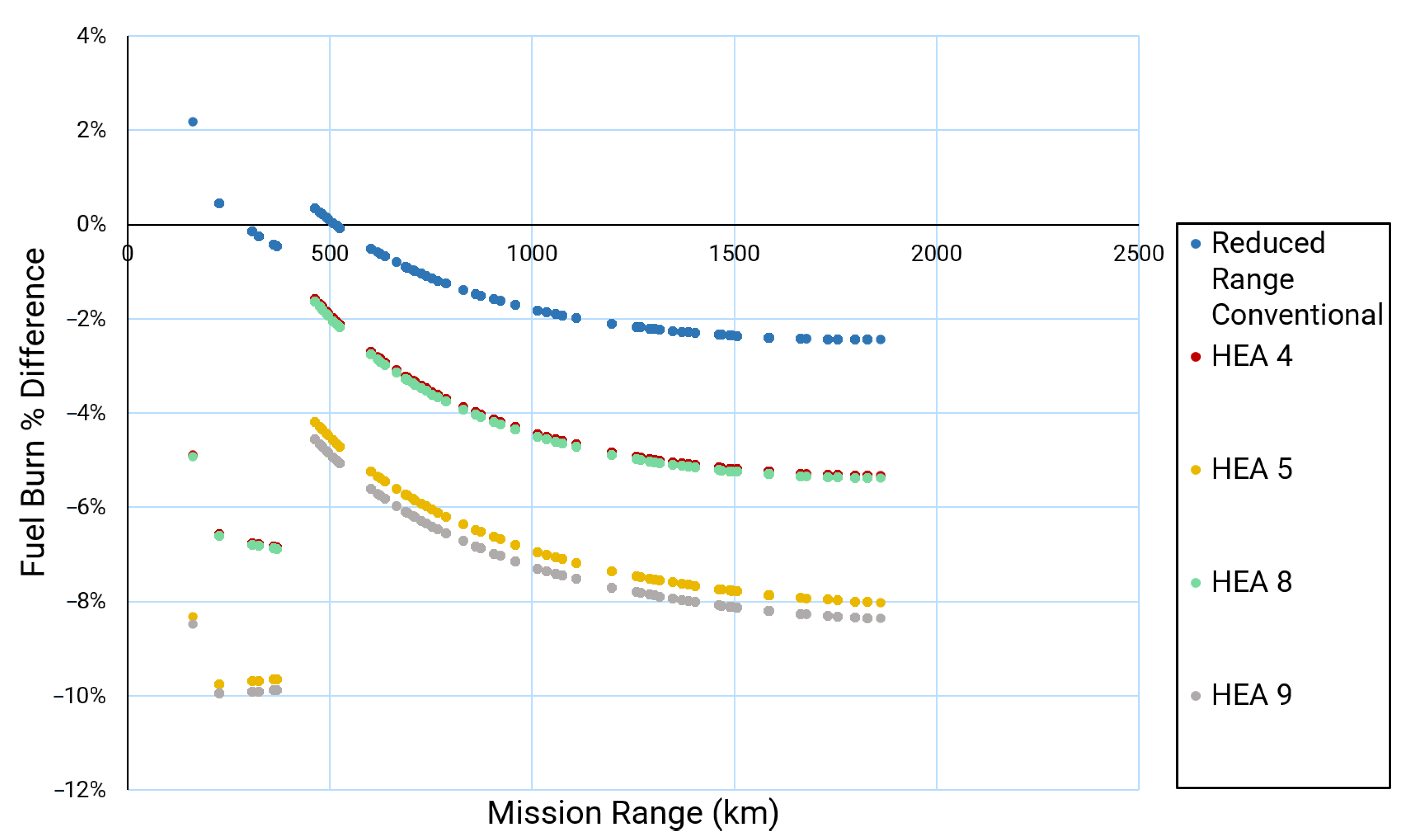
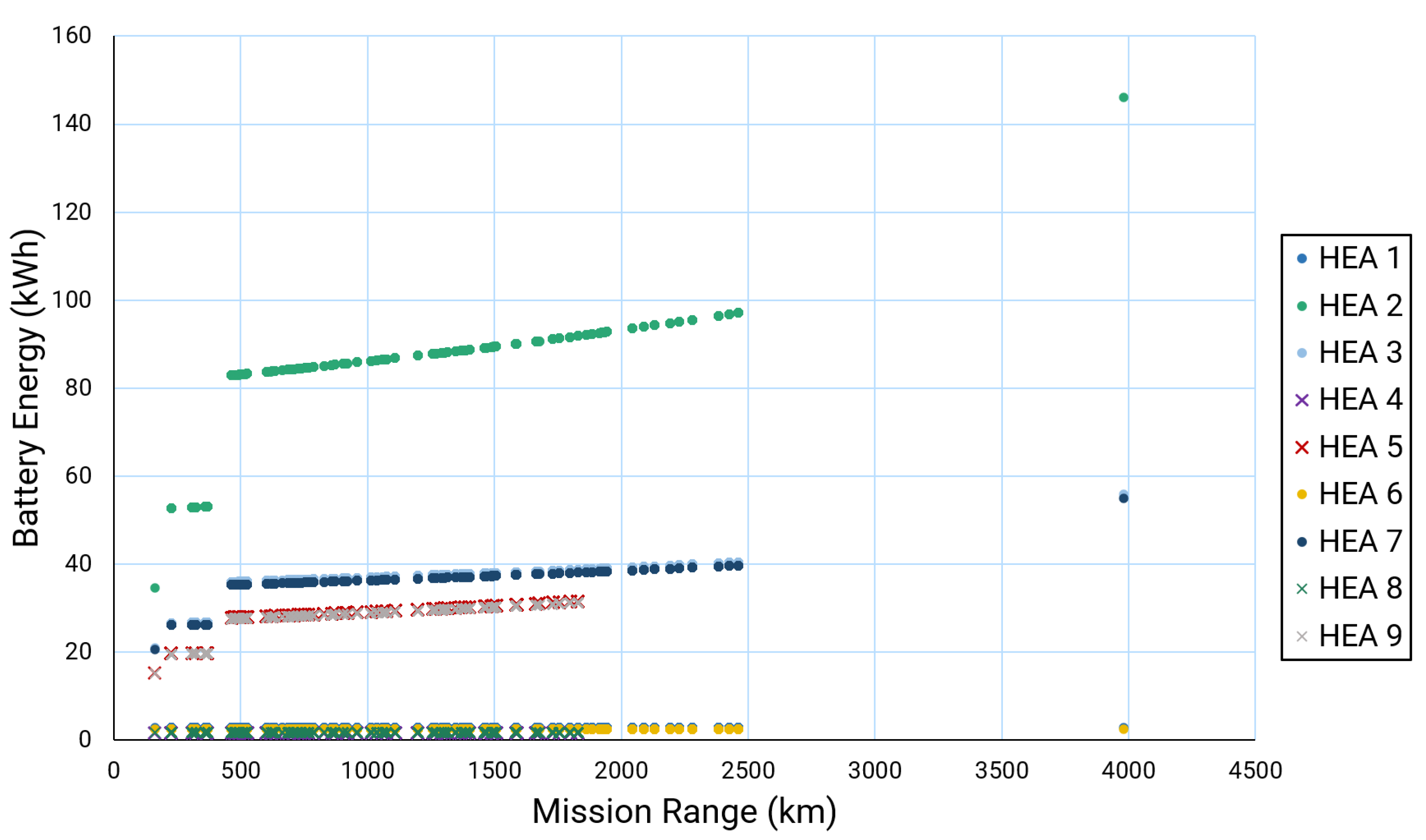
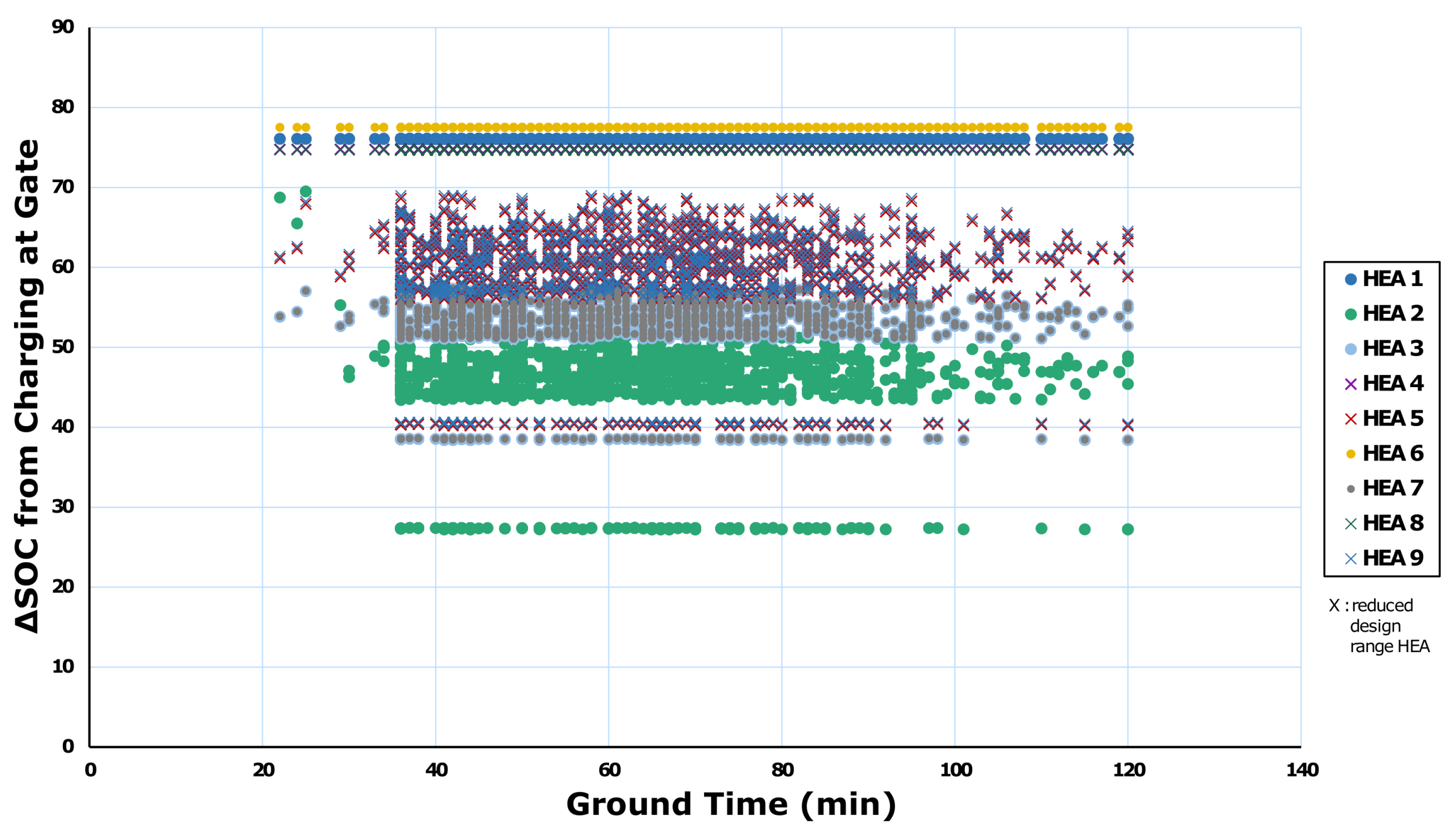
| Payload [kg] | 7430 |
| Range [km] | 3980 |
| Cruise Altitude [m] | 10,668 |
| Cruise Speed [Mach] | 0.78 |
| Thrust–Weight Ratio | 0.3392 |
| Wing Loading [kg/m2] | 533 |
| Literature | Baseline | Reduced Range | |
|---|---|---|---|
| Range [km] | 3980 | 3980 | 1850 |
| MTOW [kg] | 38,790 | 38,637 | 26,634 |
| (−0.39%) | (−31.07%) | ||
| OEW [kg] | 21,500 | 21,545 | 13,932 |
| (+0.21%) | (−35.33%) | ||
| Block Fuel [kg] | 9428 | 9398 | 5008 |
| (−0.33%) | (−46.71%) | ||
| Total Engine Weight [kg] | 2856 | 2926 | 1978 |
| SLS Engine Thrust [kN] | 60.14 | 61.71 | 42.54 |
| Avg. Cruise TSFC | 19.26 | 19.62 | 24.40 |
| Wing Area | 72.74 | 72.46 | 49.98 |
| Parameter | Units | Minimum Value | Maximum Value |
|---|---|---|---|
| Design Range | km | 1850 | 3980 |
| Battery Gravimetric Specific Energy | Wh/kg | 250 | 500 |
| Takeoff Power Split | % | 0 | 10 |
| Climb Power Split | % | 0 | 5 |
| Baseline | HEA 1 | HEA 2 | HEA 3 | |
|---|---|---|---|---|
| Takeoff Power Split [%] | - | 8.5 | 8.5 | 10.0 |
| Climb Power Split [%] | - | 0.0 | 3.0 | 1.0 |
| MTOW [kg] | 38,637 | 37,121 | 38,952 | 36,775 |
| (−3.92%) | (+0.82%) | (−4.82%) | ||
| OEW [kg] | 21,545 | 20,321 | 21,583 | 20,057 |
| (−5.68%) | (+0.18%) | (−6.91%) | ||
| Block Fuel [kg] | 9398 | 9048 | 9048 | 8771 |
| (−3.72%) | (−3.72%) | (−6.67%) | ||
| Battery Weight [kg] | - | 58 | 627 | 253 |
| Total Engine Weight [kg] | 2925 | 2563 | 2694 | 2495 |
| Total Thrust [kN] | 123.4 | 118.6 | 124.4 | 117.5 |
| SLS Engine Thrust [kN] | 61.7 | 54.3 | 56.8 | 52.9 |
| (−12.37%) | (−7.91%) | (−14.70%) | ||
| Avg. Climb TSFC | 14.76 | 14.36 | 13.87 | 14.28 |
| Avg. Cruise TSFC | 19.62 | 19.23 | 18.73 | 19.18 |
| Wing Area | 72.46 | 69.58 | 73.02 | 68.93 |
| Electric Motor Power [kW] | - | 700 | 735 | 816 |
| Electric Motor Weight [kg] | - | 70.0 | 73.5 | 81.6 |
| Reduced Range | HEA 4 | HEA 5 | |
|---|---|---|---|
| Takeoff Power Split [%] | - | 6.5 | 6.5 |
| Climb Power Split [%] | - | 0.0 | 1.0 |
| MTOW [kg] | 26,679 | 26,267 | 26,355 |
| (−1.38%) | (−1.05%) | ||
| OEW [kg] | 13,932 | 13,625 | 13,676 |
| (−2.20%) | (−1.84%) | ||
| Block Fuel [kg] | 5008 | 4915 | 4825 |
| (−1.86%) | (−3.66%) | ||
| Battery Weight [kg] | - | 33 | 160 |
| Total Thrust [kN] | 85.1 | 83.9 | 84.2 |
| SLS Engine Thrust [kN] | 42.5 | 39.2 | 39.4 |
| (−7.80%) | (−7.49%) | ||
| Total Engine Weight [kg] | 1978 | 1809 | 1816 |
| Avg. Climb TSFC | 19.39 | 18.70 | 18.61 |
| Avg. Cruise TSFC | 24.44 | 23.76 | 23.70 |
| Wing Area | 49.98 | 49.24 | 49.42 |
| Electric Motor Power [kW] | - | 379 | 380 |
| Electric Motor Weight [kg] | - | 37.9 | 38.0 |
| Configuration | Design Range [km] | Battery Specific Energy [Wh/kg] | Takeoff Power Split [%] | Climb Power Split [%] |
|---|---|---|---|---|
| HEA 1 | 3980 | 250 | 8.5 | 0.0 |
| HEA 2 | 8.5 | 3.0 | ||
| HEA 3 | 10.0 | 1.0 | ||
| HEA 4 | 1850 | 250 | 6.5 | 0.0 |
| HEA 5 | 10.0 | 1.0 | ||
| HEA 6 | 3980 | 500 | 8.5 | 0.0 |
| HEA 7 | 10.0 | 1.0 | ||
| HEA 8 | 1850 | 500 | 6.5 | 0.0 |
| HEA 9 | 10.0 | 1.0 |
| Origin | Destination | Mission Range (km) | Cruise Altitude (m) | Ground Time (min) |
|---|---|---|---|---|
| RIC (Richmond, VA) | IAD (Washington, DC) | 161 | 3962 | — |
| IAD (Washington, DC) | JAX (Jacksonville, FL) | 1013 | 10,668 | 56 |
| JAX (Jacksonville, FL) | IAH (Houston, TX) | 1313 | 10,668 | 71 |
| IAH (Houston, TX) | DCA (Washington, DC) | 1945 | 10,668 | 57 |
| DCA (Washington, DC) | IAH (Houston, TX) | 1945 | 10,668 | 37 |
| Mean | Std. Dev. | |
|---|---|---|
| Number of Flights | 3.94 | 1.09 |
| Total Distance per day (km) | 5057 | 1409 |
| Distance per Flight (km) | 1282 | 509 |
| Charge Time (min) | 59.6 | 19.2 |
| Average Daily Fuel Burn [kg] | Percent Difference | |
|---|---|---|
| Conventional Baseline | 10,726 | - |
| Reduced Range * | 10,505 | −2.05% |
| HEA 1 | 10,171 | −5.17% |
| HEA 2 | 10,319 | −3.79% |
| HEA 3 | 10,007 | −6.70% |
| HEA 4 * | 10,199 | −4.91% |
| HEA 5 * | 9914 | −7.57% |
| HEA 6 | 10,148 | −5.39% |
| HEA 7 | 9920 | −7.51% |
| HEA 8 * | 10,193 | −4.97% |
| HEA 9 * | 9877 | −7.91% |
| HEA Model | Battery | Pack-level | Battery Cells | Time to Full | |
|---|---|---|---|---|---|
| Weight (kg) | Energy (kWh) | Series | Parallel | Charge (min) | |
| 1 | 58.0 | 14.5 | 62 | 25 | 4.1 |
| 2 | 627.0 | 156.8 | 62 | 270 | 53.3 |
| 3 | 253.0 | 63.3 | 62 | 109 | 21.1 |
| 4 | 32.5 | 8.1 | 62 | 14 | 1.9 |
| 5 | 179.0 | 44.8 | 62 | 77 | 14.5 |
| 6 | 27.9 | 14.0 | 62 | 24 | 3.7 |
| 7 | 124.0 | 62.0 | 62 | 107 | 20.7 |
| 8 | 16.2 | 8.1 | 62 | 14 | 1.9 |
| 9 | 88.2 | 44.1 | 62 | 76 | 14.3 |
Disclaimer/Publisher’s Note: The statements, opinions and data contained in all publications are solely those of the individual author(s) and contributor(s) and not of MDPI and/or the editor(s). MDPI and/or the editor(s) disclaim responsibility for any injury to people or property resulting from any ideas, methods, instructions or products referred to in the content. |
© 2025 by the authors. Licensee MDPI, Basel, Switzerland. This article is an open access article distributed under the terms and conditions of the Creative Commons Attribution (CC BY) license (https://creativecommons.org/licenses/by/4.0/).
Share and Cite
Cassidy, E.; Mokotoff, P.R.; Deng, Y.; Ikeda, M.; Kirsch, K.; Li, M.Z.; Cinar, G. Design to Deployment: Flight Schedule-Based Analysis of Hybrid Electric Aircraft Variants in U.S. Regional Carrier Operations. Aerospace 2025, 12, 598. https://doi.org/10.3390/aerospace12070598
Cassidy E, Mokotoff PR, Deng Y, Ikeda M, Kirsch K, Li MZ, Cinar G. Design to Deployment: Flight Schedule-Based Analysis of Hybrid Electric Aircraft Variants in U.S. Regional Carrier Operations. Aerospace. 2025; 12(7):598. https://doi.org/10.3390/aerospace12070598
Chicago/Turabian StyleCassidy, Emma, Paul R. Mokotoff, Yilin Deng, Michael Ikeda, Kathryn Kirsch, Max Z. Li, and Gokcin Cinar. 2025. "Design to Deployment: Flight Schedule-Based Analysis of Hybrid Electric Aircraft Variants in U.S. Regional Carrier Operations" Aerospace 12, no. 7: 598. https://doi.org/10.3390/aerospace12070598
APA StyleCassidy, E., Mokotoff, P. R., Deng, Y., Ikeda, M., Kirsch, K., Li, M. Z., & Cinar, G. (2025). Design to Deployment: Flight Schedule-Based Analysis of Hybrid Electric Aircraft Variants in U.S. Regional Carrier Operations. Aerospace, 12(7), 598. https://doi.org/10.3390/aerospace12070598







